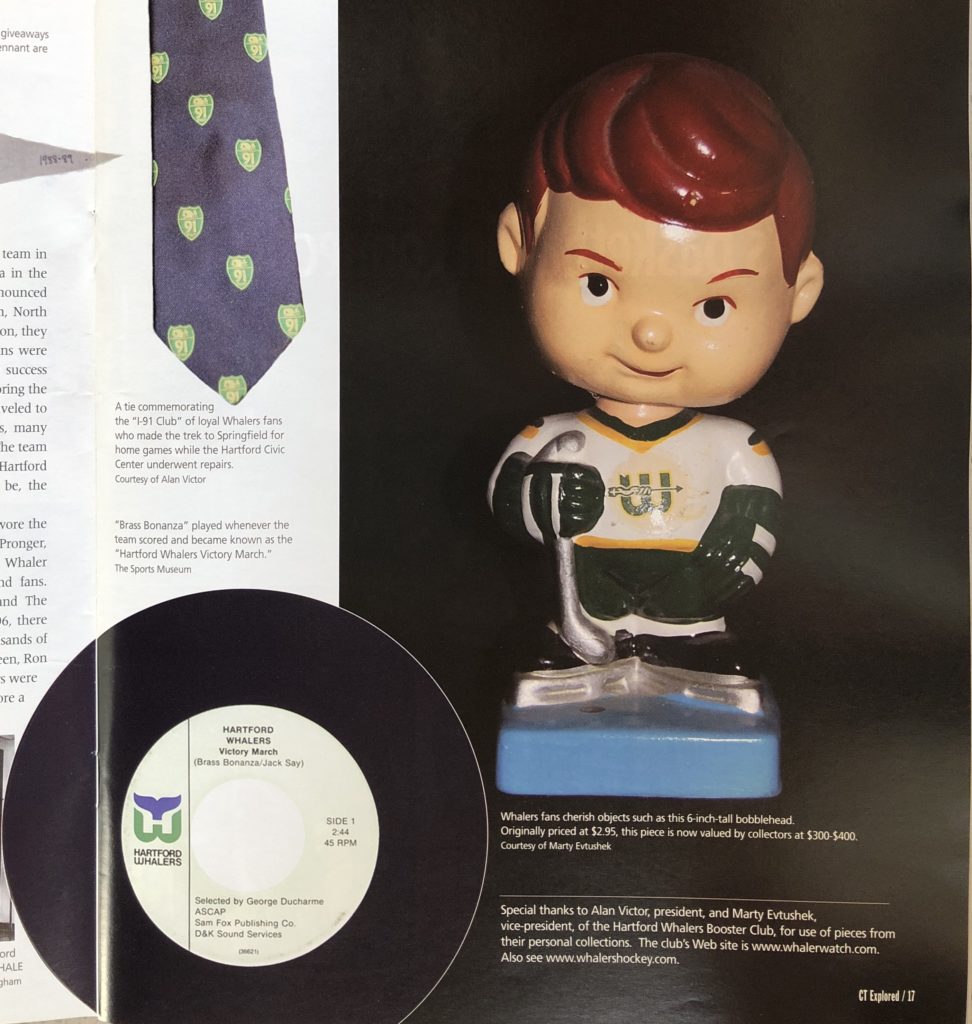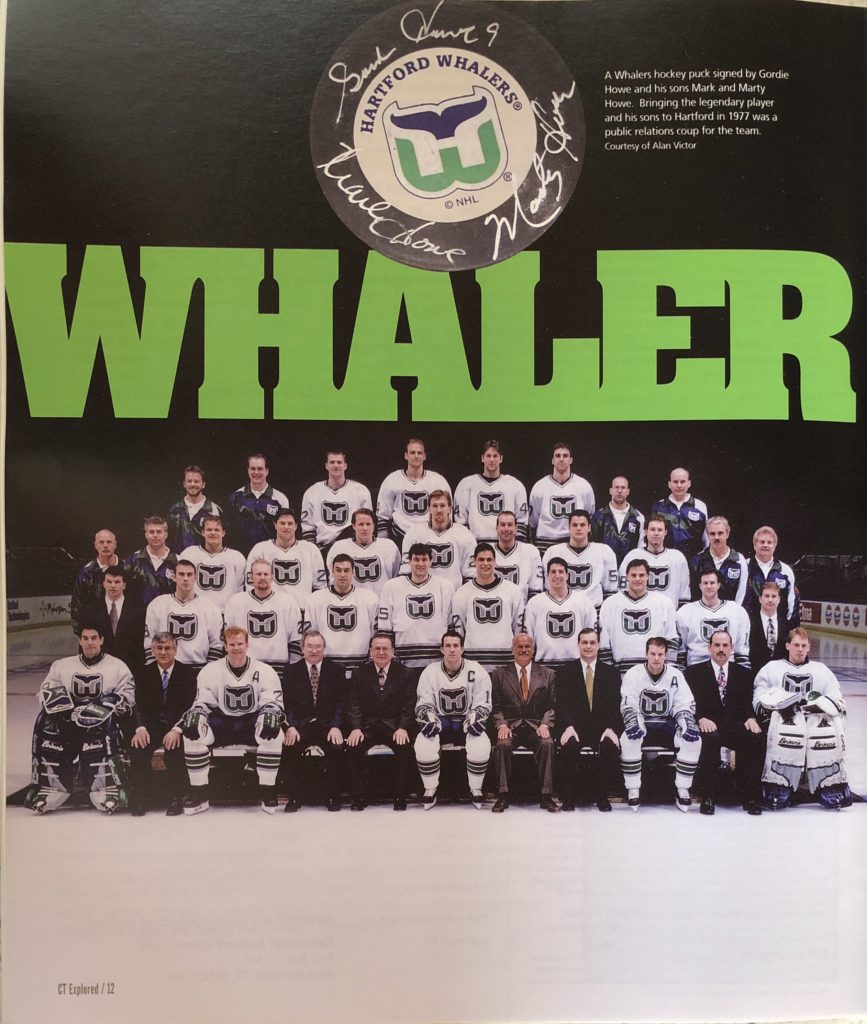
“The last team” posed for this 1996 – 1997 season photo. The next year new owner Peter Karmanos moved the team to Raleigh, North Carolina, where they played as the Hurricanes. The Sports Museum
(c) Connecticut Explored Inc. Fall 2009
Subscribe/Buy the Issue!
June 19, 2006 was a bittersweet day in Hartford. The Carolina Hurricanes, the team that until 1997 had been the Hartford Whalers, won a Stanley Cup- something the team had never achieved during its tenure in Hartford. Only one former Whaler, Glen Wesley, remained on the team. Though there was no parade in Hartford, no playing of the team’s lively fight son “Brass Bonanza,” no confetti cascading from the rafters of the Hartford Civic Center, the people of Connecticut still felt pride- tempered, for some, by a sense of loss and resentment- in the championship win. The occasion of the team’s winning professional hockey’s top prize at last was a moment to reflect on the city’s having loved – and lost – its only major sports franchise.
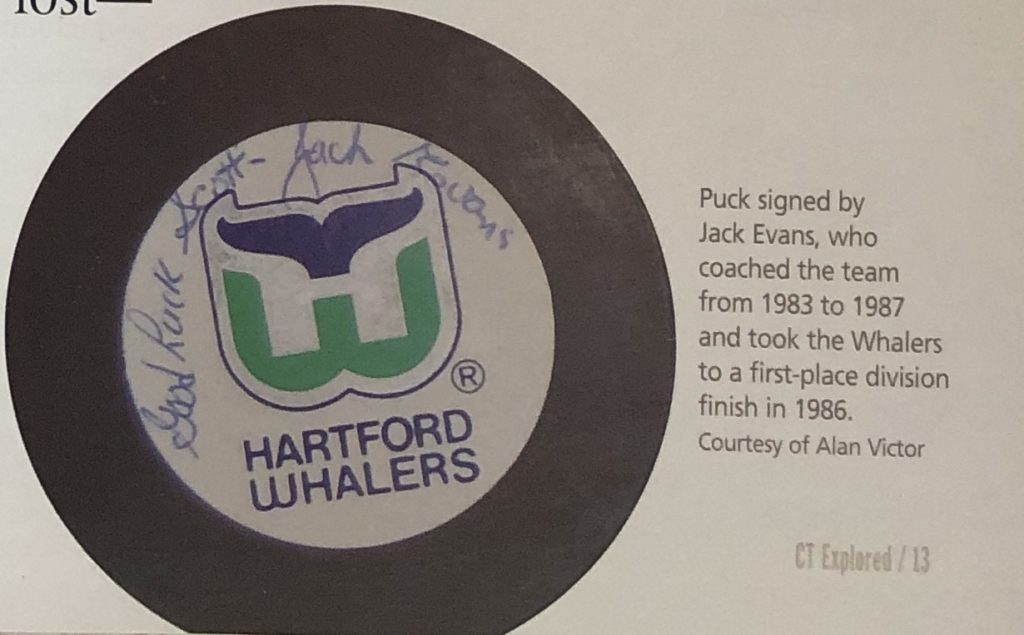
Puck signed by Jack Evans, who coached the Whalers from 1983 – 1987 and took the team to a first-place division finish in 1986. Courtesy of Alan Victor
The team that would become the Hartford Whalers got started in Boston in 1972 as the New England Whalers, playing in the fledgling World Hockey Association, organized as a rival to the 55-year-old National Hockey League. Massachusetts native (and later Whalers coach) Larry Pleau was the first to sign a contract with the Whalers; he was followed by a mixed bag of NHL players, collegians, and minor-league journey-men. The fledgling team’s star was long-time Boston Bruins defensemen Ted Green, a rough-and-tough player with a Stanley Cup win already to his name. Other NHL veterans included Al Smith (a goaltender), Brad Selwood, Rick Ley, and Jim Dorey of the Toronto Maple Leafs and ex-Bruin and Olympic gold medalist Tommy “Bomber” Williams. Williams scored the Whalers’ first goal in 1972, playing against the Philadelphia Blazers before a packed house at Boston Garden.
The New England Whalers had a very successful first season, winning the WHA’s first championship. Although they developed a following, the team was never serious competition for the city’s powerhouse NHL team, the Bruins. The “Big, Bad, Bruins,” as they were known, sold out every game; even their minor-league affiliate Boston Braves played to big crowds.
The Whalers, being the number-three team in Boston and splitting their games between the Boston Garden and the antiquated Boston Arena, began to look for a new city to call home. They chose Hartford and its new arena, the Hartford Civic Center. While they waited for the Civic Center to be completed, they played their games- including the 1974 playoffs- in Springfield, Massachusetts.
On January 11, 1975 the New England Whalers took the ice for their first game in the Civic Center, where they played before a sellout crowd. With a major-league franchise to call their own, Hartford fans embraced the team. In 1977 the Civic Center hosted the WHA All-Star game and, in the spring of that year, scored one of the major coups in hockey history by signing legend Gordie Howe, who had recently come out of retirement to play alongside his sons Mark and Marty with the Houston Aeros. The Aeros, like many WHA franchises, folded, leaving its players as free agents. Keeping the three Howes together was a great publicity move for whoever signed them; the Whalers won out in the bidding. All three now wore Hartford green.
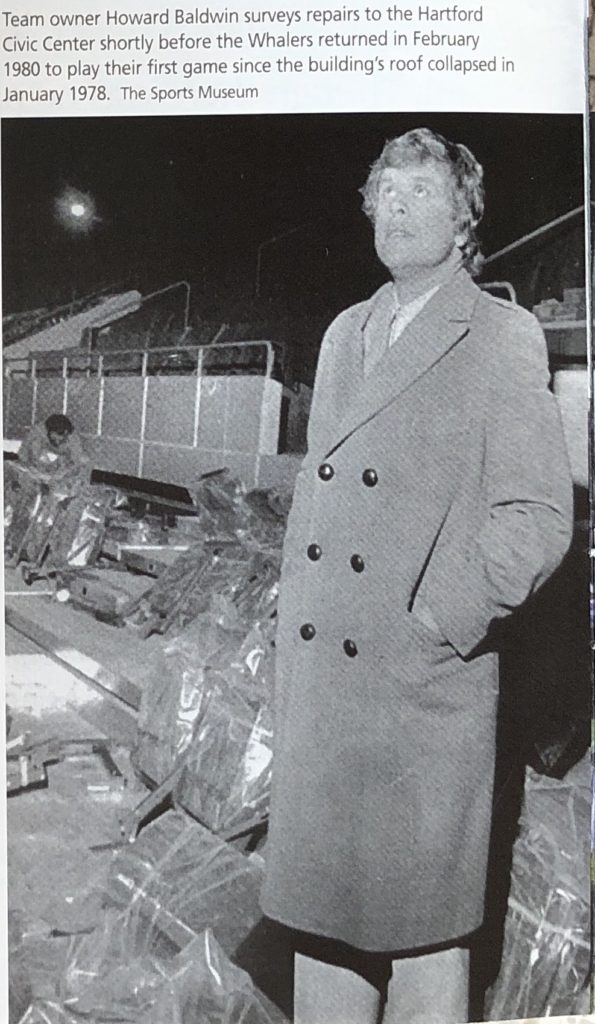
Team owner Howard Baldwin surveys repairs to the Hartford Civic Center shortly before the Whalers returned in February 1980 to play their first game since the building’s roof collapsed in January 1978. The Sports Museum
The Whalers performed swimmingly — until they faced a disastrous setback. On January 18, 1978 the Civic Center’s roof collapsed under the weight of snow and ice from a severe storm. Fortunately, nobody was injured. But the accident forced the team to relocate temporarily to Springfield. Undeterred, loyal fans formed what they called the “I-91 Club” after the highway connecting the two cities. Making the trek to Springfield for what were called the Whalers’ home games, the faithful continued to cheer on their team. The first game back in Harford was on February 6, 1980. The team was welcomed with open arms.
In 1979, along with WHA clubs Winnipeg, Edmonton, and Quebec the Whalers joined the NHL as an “expansion team” for the 1979-80 season after the WHA folded. Hartford had arrived in the Big Time, and the fans were ready. Rechristened the Hartford Whalers and sporting the now classic “HW” whale-tail logo, the club now had such NHL veterans and box office attractions as Dave Keon, Bobby Hull, and Gordie Howe (the merger deal allowed players who jumped to the NHL to remain with their new clubs rather than return to their old teams). Though the team developed rivalries with both Boston and New York, the most memorable games would be against the team they once shared a building with, the Bruins.
The golden era of Ron Francis, Kevin Dineen, Ray Ferraro, Ulf Samuelsson, Sylvain Turgeon, Pat Verbeek, and Keith Primeau had begun. Although playoff success eluded them for years, in 1986 they finally won the Adams Division Championship. And while they were knocked out of the subsequent playoffs by the Quebec Nordiques, the Hartford fans still threw their beloved team a parade- an honor usually reserved for teams winning championships, not division finals.
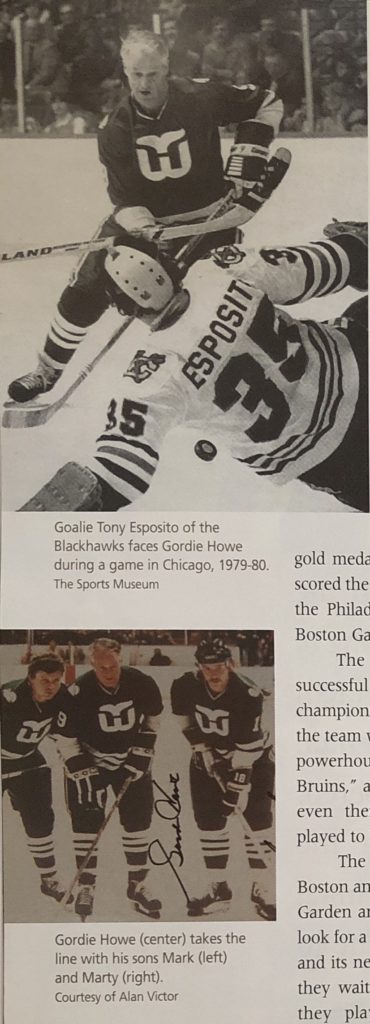
top: Goalie Tony Esposito of the Blackhawks faces Gordie Howe during a game in Chicago, 1979 – 1980. The Sports Museum; bottom: Gordie Howe (center) takes the line with his sons Mark (left) and Marty (right). Courtesy of Alan Victor
While the team enjoyed strong fan support, economic eventually reared its ugly head. In 1994 a new ownership group led by Peter Karmanos purchased the Whalers for $47.5 million. Although Karmanos, the founder of the enormously successful company Compuware, pledged to keep the team in Hartford, negotiations to build a new arena in the capital city broke down, and the team announced plans to relocate. The owners chose Raleigh, North Carolina, where, starting in the 1997-98 season, they played as the Hurricanes. While Whalers fans were heartbroken, the team finally achieved the success that they’d worked toward for so long by scoring the 2006 Stanley Cup. Devoted Whaler fans traveled to North Carolina to watch the playoff games, many wearing their beloved “Whale Tail” jerseys. The team may have moved, but for a handful of Hartford faithful they still were, and would always be, the Hartford Whalers.
Today, only a handful of players who wore the Whalers uniform still play in the NHL: Chris Pronger, Brendan Shanahan, and J.S. Giguere. Still, Whaler loyalty runs deep among both players and fans. While the love affair between Hartford and the Whale has never ended, on January 6, 2006, there was a last hurrah of sorts. On that day, thousands of Whalers fans turned out to honor Kevin Dineen, Ron Francis, and Ulf Samuelsson as their numbers were raised to the rafters of the Civil Center- before a Wolfpack game.
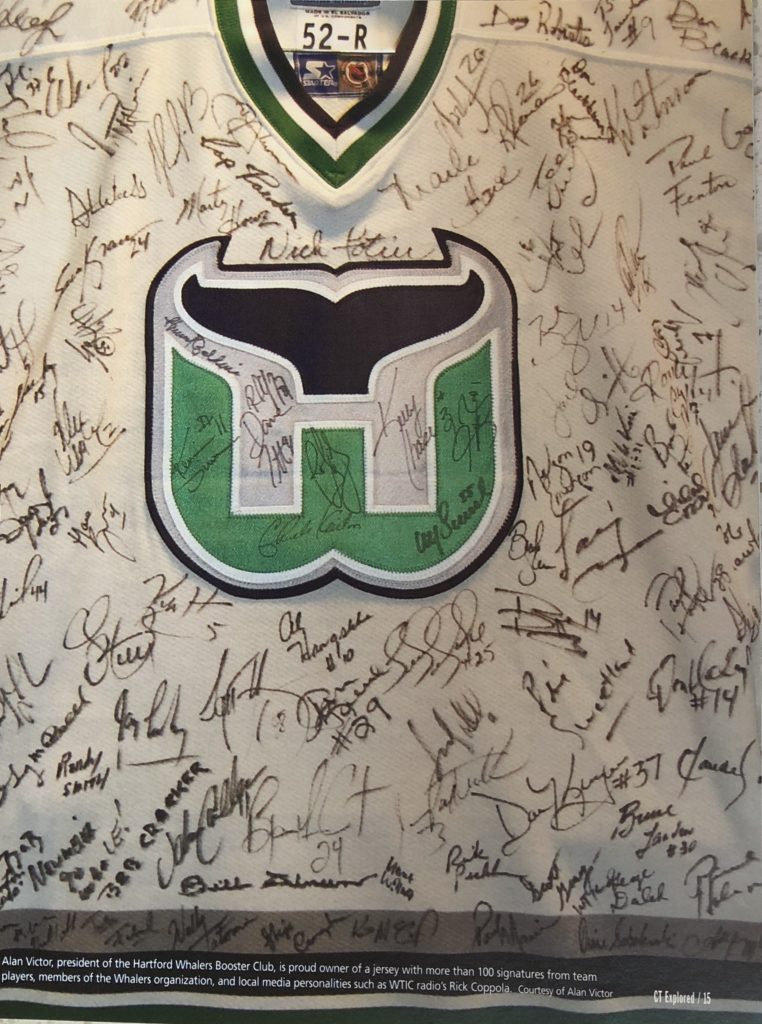
Jersey with more than 100 signatures from team players, members of the Whalers organization, and local media, owned by Alan Victor. Courtesy of Alan Victor
Brian Codagnone is the associate curator of the Sports Museum in Boston. He is the author of The Hartford Whalers and co-author of The Boston Garden and The Bruins in Black and White, volumes one and two, and the author of the cartoon collection Hey America! Its Misfits Time!
Explore!
Read more stories about Connecticut Sports History on our TOPICS page.


